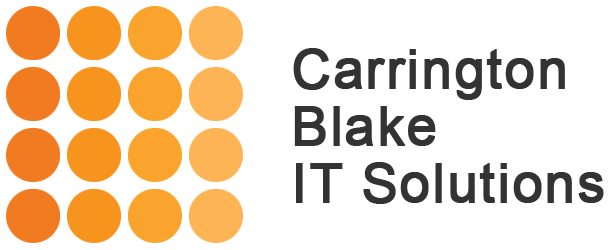
Cloud Computing for IT Managers
At Carrington Blake IT Solutions we provide IT Support and solutions with a big difference. We know the benefits and drawbacks associated with traditional on-site I.T. Support and equally, we very well understand the benefits and drawbacks of cloud based services. Our aim is to deliver to our clients the best of both worlds providing cloud solutions when they fit well with our clients objectives and local on-premises solutions when more appropriate.
We understand that as cloud services mature and become mainstream most of our clients will need to seriously consider migrating locally delivered services into cloud or data centre managed services. It is not a question of if it will happen , its more a question of when. At Carrington Blake IT Solutions we support and enhance traditional on-site deployments but we also consult to assist with the assessment of cloud delivered services when the time is right.
When researching products to consider the potential for cloud services there is initially some confusion as to where a particular product may fit into an existing infrastructure.. Sales and product marketing literature will liberally claim to be providing a cloud solution when all along it could be a data centre co-location service (COLO) or even a software application such as SalesForce (SAAS). In fact there are 6 categories of cloud products which are entirely different and have strikingly different advantages and disadvantages.
Cloud Ground Zero
This is the starting point, i.e. no cloud services are being used at all. Servers, workstations are locally owned and deployed with the employment of an IT Manager, department or external IT support company. Applications are installed directly onto local PC’s. This is the traditional starting point which is where most of our clients are working when we are first introduced.
At ground zero it is often not cost effective to engineer adequate provision for Business Continuity. Recovery times in the face of a total loss can be many days at best and often will be two weeks to allow procurement and provision of new hardware and to restore data from backup tapes.
We often discover when we meet potential clients that the downtime risk carried at this level is often much longer than the business can tolerate.
-
Off-Site Backup
Many of our clients will have found that operating backup tapes can be tedious and unreliable since daily human intervention is required. The first step towards cloud is to employ an off-site backup service to eliminate tape management.
The main drawback is that recovery and restoration times with standard off-site backup services can be delayed and very unreliable when data is being streamed back onto site via a limited bandwidth internet connection.
At Carrington Blake IT Solutions we provide off-site backup solutions which eliminate this drawback so creating a best of both worlds backup and rapid recovery solution.
-
Co-Location (COLO)
Servers and associated computer systems may be moved into a co-location facility in a modern data centre. This greatly improves reliability and up-time as well as higher internet bandwidth and reliable connectivity. The client will still own the hardware and will pay a co-location charge to purchase power, cooling, internet bandwidth and often some rudimentary “smart hands” service which will deal with any physical work which may be required.
At this level the equipment is still owned and operated by our client. This situation is often demanded by software vendors who refuse to license their products unless the licensee physically owns the hardware. As cloud services become mainstream such restrictions are being removed or work arounds negotiated.
At this level the client data is hosted on their own hardware and the data security is clearly under their own direct control which is sometimes a cultural requirement and sometimes a compliance requirement. As cloud managed services become main stream our clients are realising that data security and compliance is enhanced when true cloud managed services are employed.
At this level there are some business continuity and reliability gains, however it is seldom cost effective to duplicate all of the hardware into a second data centre and to replicate data to both data centres and to provide fail-over functionality. The steps towards true Business Continuity remain complex and expensive to implement.
-
Infrastructure as a Service (IAAS)
At this level the hardware and associated infrastructure and resources are being rented from the cloud provider. Many different charging structures are available from flat monthly fees (equipment rental in effect) to per-hour and metered pricing.
This is the largest growth area in cloud computing and many different products exist which deserve their own sub-categories. For example Amazon Web Services (AWS) will rent virtualised servers on a per hour basis and other companies will rent a pre-configured Windows Server with metered and on-demand resources.
In many cases it is not an easy job to migrate an existing on-premises infrastructure over to an IAAS provider, although I am sure this statement will offend many such providers, there is still an experienced IT Manager required to design the solution and network and to look after the clients best interests in the face of complex charging structures.
The biggest problem at this level is budgeting and predicting the metered usage costs. A little bit like leaving a mobile phone connected to an international number for hours by mistake it is perfectly possible for the metered costs liability to escalate out of the clients direct control either through incoming web server demand or just a technical error.
-
Platform as a Service (PAAS)
Carrington Blake believe Platform as a Service is the most compelling cloud service for most of our clients. The complexities and cost risks associated with the lower levels of cloud are absorbed by us into a simple flat rate per user per month fee.
However the most compelling feature is the inclusive business continuity benefit. The Carrington Blake TopDesk virtual desktop product includes for no extra charge a twin data centre backbone. The primary data centre is with “The Bunker”, Sandwich Kent and the Secondary Data Centre is located at “The Bunker”, Newbury Berks. Periodic snapshots are taken of the client data are transmitted to the secondary data centre where all of the client services can be re-provisioned on demand. This backbone is the main key point of difference which provides our clients with a peace of mind infrastructure, which not only protects against their office failure, but also protects against most single points of failure inside our own infrastructure.
Another important feature is that TopDesk is designed to host existing client owned software which would normally be installed on a local workstation. The product is designed to effectively lift the entire computer system from a client office and deliver the same or better service from the cloud, to any device at any location at any time.
TopDesk takes all of the complexity of IT wraps it up into a simple pricing structure and delivers the applications with a service level agreement seldom possible using Ground Zero computing with either internal or external support.
The technologies being employed and integrated to produce TopDesk are very well known and well proven in the industry. Windows Server 2008R2 (64bit) is the underlying operating system delivering the Windows 7 experience. VMware is being used as the virtualisation layer with a tiered storage controller (SAN) system being used to manage the hard disk storage. Terminal Services are used to deliver the users windows session with a profile manager used to ensure that the user is able to enjoy our fully load balanced server farm. Most of our clients have the benefit of a private active directory server (Private Cloud), with our smaller clients enjoying a multi-tenanted server farm.
Another key benefit to TopDesk is the outcome from the users point of view is almost transparent. Apart from a different way to log-in, the business processes and applications work in exactly the same way as they did using ground zero computing.
-
Software as a Service (SAAS)
Industry experts predict that computing will eventually evolve entirely into the SAAS level.
Pioneering products such as SalesForce and Google Apps are currently effective and commercially viable in this space.
Our customers however find the migration to these services to be highly disruptive to existing business processes. Inter-application communication such as mail merge or address lookups to legacy software applications become impossible or confusing unless some kind of bespoke development or specialised export / import process is undertaken.
Our clients usually wish to avoid bespoke development and simply want their system to be delivered from the cloud and to emulate as closely as possible their existing processes. This is achieved by retaining the familiar windows desktop.Software as a service will no doubt evolve into a total solution, however we believe that the Platform as a Service allows our clients to mix and match software vendors and can avoid one size fits all solution.
Another important consideration is the jurisdiction and location of the client data. Many SAAS companies use offshore servers and data centres which give rise to compliance risks and exposure to offshore legislations such as the US Patriot Act, which we believe is important to many of our clients.
The Carrington Blake IT Solutions TopDesk product is entirely UK owned and operated and is compliant to UK legislation and jurisdiction.

GIVE US A CALL
|

ARRANGE A CALL BACK |

REQUIRE IMMEDIATE SUPPORT? |

EMAIL AN ENQUIRY |






